
JAPANESE PRINTS
A MILLION QUESTIONS
TWO MILLION MYSTERIES
Ukiyo-e Prints浮世絵版画 |
|
formerly Port Townsend, Washington now Kansas City, Missouri |
|
UTAGAWA TOYOKUNI III |
|
|
三代目歌川豊国 |
|
|
1786-1865 |
|
|
Subject: Ishikawa Goemon and Mashiba Hisayoshi |
|
|
石川五右衛門 |
真柴久吉 |
|
From the play Sanmon Goemon no Kiri Correction: We now believe the true reading of this title should be Sanmon Gosan no kiri and now another correction: Hama no Masago Tsukinu Gohiki; Scene from Act II: Nanzenji Sanmon no Ba |
|
|
桜門五三桐 |
|
|
Publisher: Kobayashi-ya Tajirō |
|
|
小林泰治郎 |
|
|
Print Sizes: 14 1/8" x 9 7/8" Each |
|
|
Mat Size: 33 3/4" x 14 1/4" |
|
|
Date: 3/1851 or a little later after it was performed at the Kawarazaki-za. |
|
|
Censors: Hama (Hama Yahei - 浜弥兵衛) and Magome (Magome Kageyu - 馬込勘解由) |
|
|
濱 |
馬込 |
|
$590.00 SOLD! |
|
|
There is another copy of this diptych in the National Diet Library in Tokyo, Japan and in the Victoria and Albert Museum. |
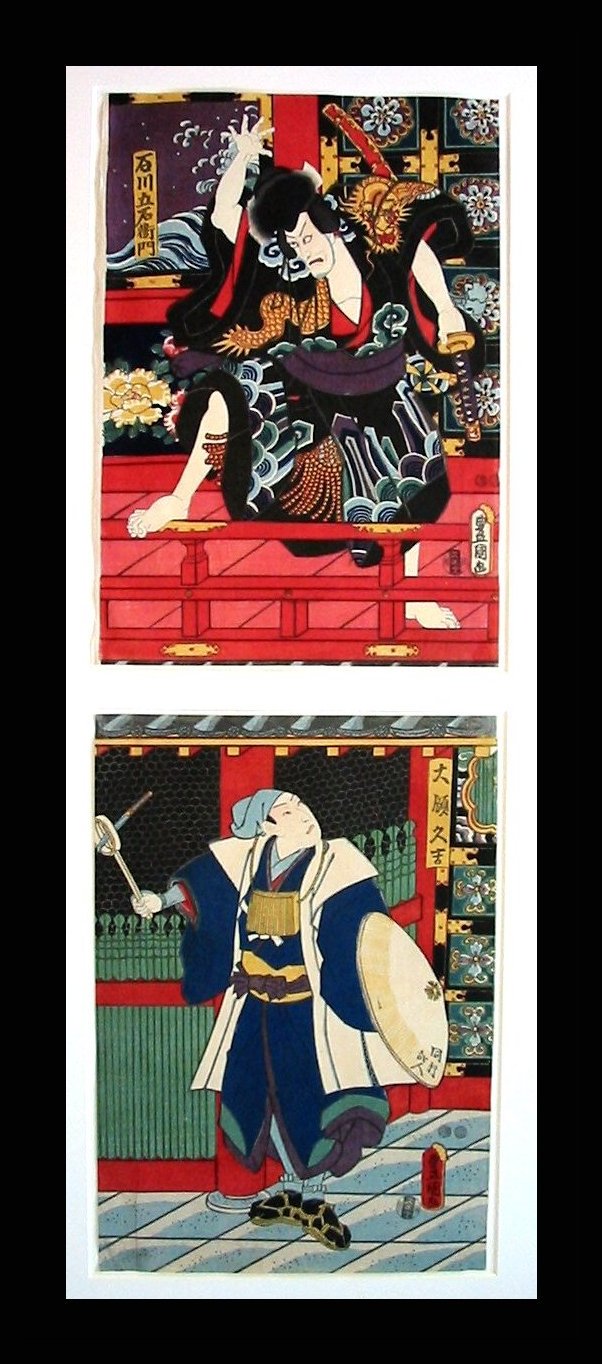
|
THE HEAVEN POSITION THE EARTH POSITION |
|
THE TENCHI no MIE 天地の見得 |
|
|
|
At the climax of the play when Goemon confronts Hisayoshi the two adopt the Heaven and Earth poses. Goemon on the balcony places one foot on the railing while clutching his sword with his right hand - eyes bulging, lips parted. Hisayoshi assumes the earth position with dagger impaled dipper raised skyward. The curtain falls.
|
|
Source: Kabuki Plays on Stage: Villainy and Vengeance, edited by James K. Brandon and Samuel L. Leiter, Published by the University of Hawai'i Press, Honolulu, 2002, Vol. 2, entry and translation by Alan Cummings, p. 80 |
|
|
|
|
|
|
|
DIPPERS AND DAGGERS |
|
|
|
According to Kabuki Plays on Stage (Vol. 2, p. 80) when Goemon and Hisayoshi meet at the temple gate the latter turns to face his rival and says "Alms for the pilgrim!" "Goemon raises his right hand and mimes hurling a dagger to a single loud tsuke beat. Raising the water dipper Hisayoshi - via stage trickery - seems to calmly catch the dagger with it and faces front..." |
|
|
|
MAGIC BULLETS
In the West we have things like silver bullets to kill werewolves, sunlight or stakes to destroy vampires, water for melting Wicked Witches of the West and salt to kill slugs. So, why shouldn't the Japanese have their own magic panaceas? Obviously they did. If only these things still worked today. But wait! Salt still does and it is still relatively cheap and accessible. |
|
|
|
|
|
|
|
|
|
|
|
|
|
Publisher: Kobayashi Tajirō |
|
Censor Seals: Hama & Magome 1849-53 |
|
|
|
|
|
|
|
|
|
Ishikawa Goemon Mono A Genre |
|
石川五右衛門物 |
|
|
|
It is said that Davy Crockett 'killed him a bar when he was only three', Mozart composed his first symphony at about the same age even if it was a bit heavy on the trumpet and kettledrum sides and Mendelssohn composed his famous octet at sixteen --- something more wizened composers would have loved to have written by the time they died. While I don't believe the part about Davy Crockett I do recognize that such is the meat of legends. And so it was with Ishikawa Goemon, a bandit of the late sixteenth century. By the time Hideyoshi's troops were able to capture him and boil him and his son alive in the Kamo's dry river bed at Sanjōgawara near Kyōto the making of a legend had already started. Supposedly Goemon was caught in the act of burglarizing a house when he was only sixteen years old. He slew all three of the men who tried to stop him. One can hardly believe that Bonnie and Clyde were anywhere near as beautiful and tragic/heroic as they were portrayed by Faye Dunaway and Warren Beatty in Arthur Penn in 1967, but it did make for a terrific movie. Well, by the late 17th century Goemon had been transformed into something mythic. The first puppet play appeared in the 1680s followed by another in 1712 by Chikamatsu Monzaemon. The first kabuki production was in 1751 in Osaka. By 1789 "...Goemon, having become a 'chivalrous robber' in order to protect his lord's daughter Okono and to restore the family fortunes, is captured but saved in the nick of time from being cooked alive." (Perhaps now someone could rewrite Bambi and save his mother. I might watch that one.) But the theatrical dissembling was just getting started. In the 1751 production Goemon was made into a transposed Kagekiyo, a warrior from the Heike saga of the 12th century. Then in 1778 Goemon was portrayed as having brazenly made his way into Hideyoshi's castle. Not only that but Hideyoshi is confronted by this 'superhuman rebel'. Morphing even included female Goemon figures like his mother. Pleeeeeze! Goemon arrived on the Edo stage in 1782 disguised as a bean curd dealer intent on a moral mission. An 1809 play stressed his love of his wife and son. And there were many more. In fact, in one version from 1782 he "...mistakenly kills a girl in order to obtain her liver (used as a life-saving medicine)..." How does one mistakenly kill a girl for her liver? Is that anything like mistakenly killing a rhino for the aphrodisiac properties of its horn? Or, a tiger for its.... You fill in the blank. |
|
|
|
Sources and quotes above are from: New Kabuki Encyclopedia, comiled by Samuel L. Leiter, Greenwood Press, 1997, p. 224. |
|
CORRECT ME IF I AM WRONG PLEASE |
||
|
|
||
|
O-FUDA 御札 A protective charm |
||
|
|
||
|
|
|
|
|
I have long been intrigued by the item which hangs around the neck of the figure shown at the bottom of the vertical diptych featured on this page. While there are many variations on this theme of confrontation between Goemon and Hisayoshi not all of them contain this element. However, on the other hand, many of them do. According to a passage in volume 2 of the Kabuki Plays on Stage "Tied to his obi are numerous seals from the temples he has visited..." (1) While this description does not conform absolutely to the images I have seen it does make sense that it refers to what, for lack of a better term until now, I have referred to as 'clackers' hanging on the characters chest.
So, what are they if not 'clackers'? I think I know now: they are o-fuda or protective charms. Perhaps they have a dual purpose: 1) en masse they would have a greater prophylactic role and 2) they would indicate by their numbers the extreme devotion of the wearer. According to Professor Brian Bocking o-fuda like o-mamori (御守り) serve as "...amulets to ward off misfortune and as talismans to bring benefits and good luck." (2) O-fuda ..."come in various sizes and typically comprise a flat and slightly tapered piece of wood (sometimes paper) on which is inscribed or stamped in black and red ink the name of the shrine/temple and the kami enshrined." (3) Bocking notes that these amulets can be acquired at both Buddhist and Shinto shrines. |
||
|
|
||
|
1. Kabuki Plays on Stage: Villainy and Vengeance, edited by James K. Brandon and Samuel L. Leiter, Published by the University of Hawai'i Press, Honolulu, 2002, Vol. 2, entry and translation by Alan Cummings, pp. 79-80. 2. A Popular Dictionary of Shinto, by Brian Bocking, NTC Publishing Group, 1997, p. 135. 3. Ibid., p. 136. |
||
|
I WAS REREADING KUNISADA'S WORLD by Sebastian Izzard last night. For anyone who hasn't read it or doesn't own a copy I can't recommend it enough. It provides a wealth of information that is invaluable to anyone interested in the subject of Ukiyo-e. Anyway, I was reading and after the introductory essays started looking at the catalogue entries. Number one was a revelation even though I had read this book before. When I purchased three vertical diptychs by Kunisada, aka Toyokuni III, I did so because I thought of them as comparitively unique within his oeuvre --- which they are. But what I had forgotten was that catalogue entry number one from the exhibition shown at the Japan Society in 1993 was in fact a vertical diptych dating from the very beginning of Kunisada's career. |
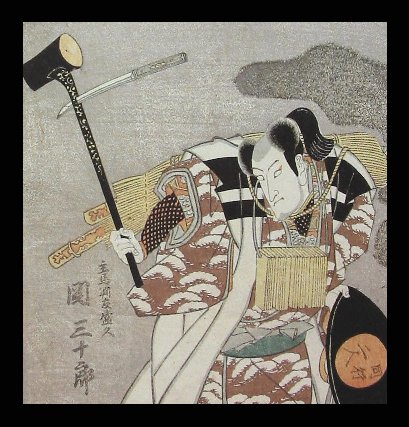
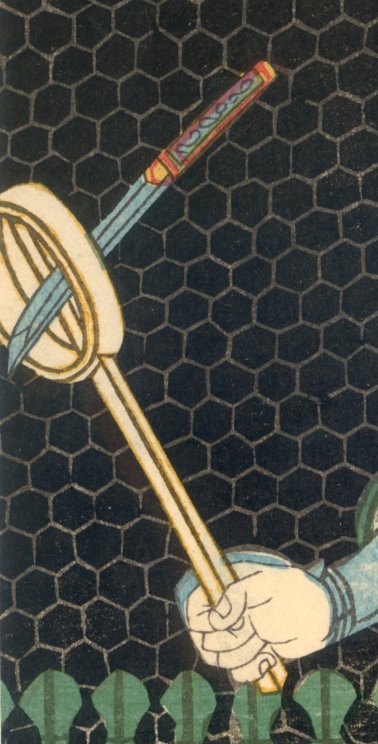
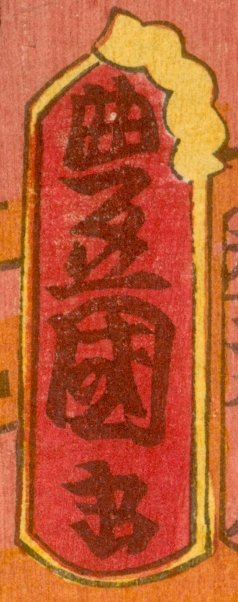
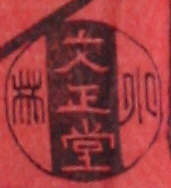

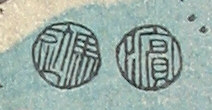
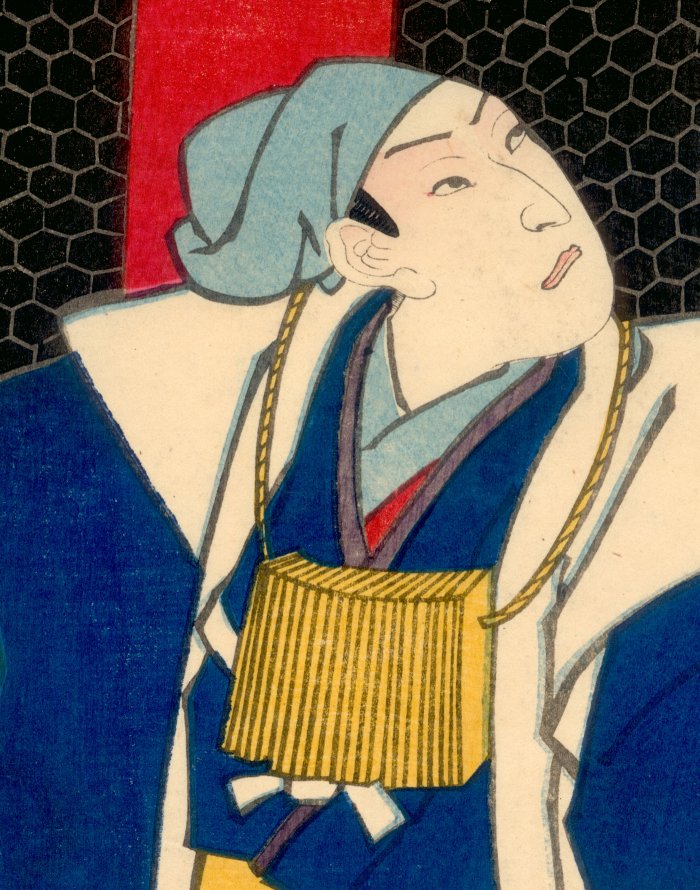
 HOME
HOME